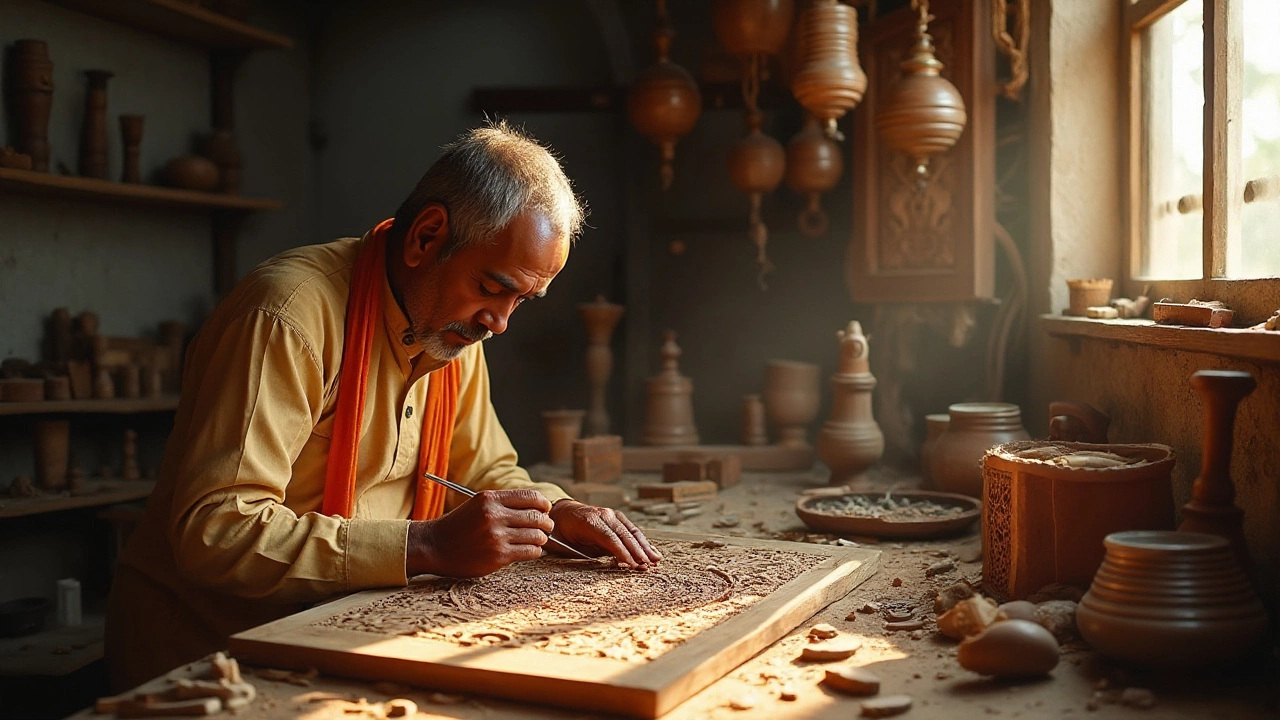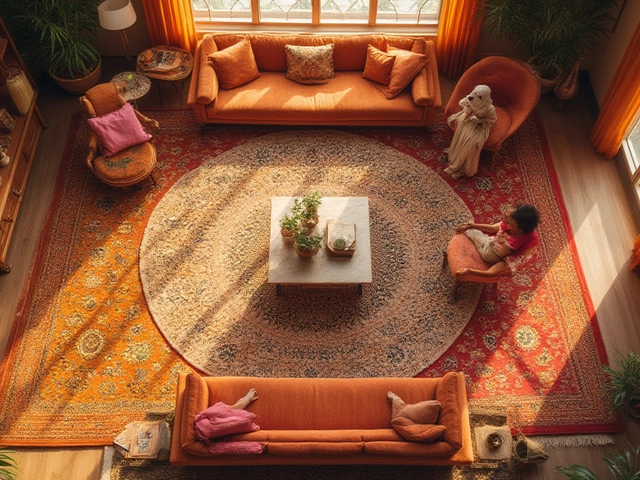
India has long been celebrated as a hub of excellent craftsmanship, particularly when it comes to furniture making. With a history rich in tradition and innovation, Indian furniture stands as a testament to the country's diversity and creative spirit. From intricately carved wooden pieces to sleek, modern designs, India houses a wealth of furniture styles that cater to a variety of tastes.
Whether it is the expertly crafted woodwork from Rajasthan or the modern minimalist designs emerging from metropolitan cities, India's furniture industry is vast and varied. Indian manufacturers are known for their ability to infuse traditional craftsmanship with contemporary aesthetics, resulting in furniture that is not only functional but also artistically significant.
This piece explores why India's furniture industry is held in such high regard globally, delving into the cultural influences, materials, and leading brands that have helped elevate the country's reputation in this field. Join us as we uncover what makes Indian furniture truly remarkable and why it continues to capture the hearts of so many around the world.
- The Heritage of Indian Furniture Making
- Materials and Techniques Used
- Influence of Culture and Craftsmanship
- Leading Indian Furniture Manufacturers
- Comparative Analysis with Other Countries
- Why Choose Indian Furniture for Your Home
The Heritage of Indian Furniture Making
Steeped in a rich tapestry of history and cultural diversity, India’s journey in furniture making spans centuries, drawing from various dynasties and traditions that have shaped its aesthetic. From the intricate carvings of the Mughal era to the elegant simplicity inspired by the colonial period, the evolution of furniture in India is a testament to its geographic and cultural shifts. The heritage of Indian furniture is not merely a tale of artistic expression but also one of advanced craftsmanship skills passed down through generations. The mix of ancient artistry with regional influences has borne a unique style that continues to enchant the world.
The earliest signs of furniture making in India can be traced back to the Indus Valley Civilization, where wood and stone were skillfully used to create utilitarian yet stylish items. Over the ages, different empires left their mark on Indian craftsmanship. The Mughal rulers introduced opulence in furniture design, emphasizing intricate carvings and inlays that were often embellished with precious stones. This period saw the rise of wonders such as the Peacock Throne, an embodiment of luxury and artistry. On the other hand, the colonial era brought about changes in design philosophy with a blend of Indian and European elements, giving rise to new styles that reflected an amalgamation of cultures.
Master artisans, known as ‘Suthars,’ played a crucial role in keeping these crafts alive. They were traditionally found across villages, known for their meticulous handiwork and dedication to maintaining impeccable standards. These craftsmen relied on local materials like teak and rosewood, which were not only durable but provided a rich texture to the furniture. Even today, regions like Rajasthan, Gujarat, and Kerala are renowned for their distinctive techniques and styles, each offering something unique to the spectrum of Indian furniture.
Significantly, a revival of ancient techniques has been observed in modern times. As global consumers increasingly lean towards sustainable and ethical designs, the demand for furniture that tells a story and carries with it the weight of generations has soared. Indian furniture manufacturers have responded to this trend by pursuing traditional methods with renewed vigor, sometimes merging them with contemporary designs to cater to an international audience. This ability to toggle between past and present uniquely positions Indian furniture as timeless yet trendy.
According to an article quoted in Architectural Digest, the global appeal of Indian furniture lies in its ‘ability to convey stories through its intricate detailing and exotic woodwork.’
This artistic heritage, with its deep spiritual symbolism and lavish concepts, tells tales of India's multifaceted society and stands as a bridge between the country's past and how it positions itself in the modern world.As individuals around the globe strive to infuse their living spaces with pieces that carry cultural significance, Indian furniture increasingly finds its place on the international stage.
Materials and Techniques Used
When it comes to crafting fine furniture, Indian artisans have always displayed an impeccable ability to harmonize traditional methods with modern innovations. This balancing act is particularly evident in the materials and techniques they use. Furniture manufacturers India are renowned for their expert use of local woods, such as Sheesham and mango wood, known for their durability and appealing grain patterns. These materials not only lend an air of authenticity but are also sustainably sourced, an aspect increasingly appreciated by the global consumer.
Sheesham wood, also known as Indian Rosewood, is particularly favored for its rich color and natural grain that offers each piece a unique look. This type of wood is native to the Indian subcontinent and is known for its strength, ensuring that the furniture crafted from it withstands the test of time. Craftsmen adeptly carve Sheesham into intricate designs that reflect the cultural tapestry of India. Such craftsmanship is not just about the final product but also involves a respect for tradition and a deep understanding of material properties.
"Indian furniture doesn’t just fill a room—it tells a story of heritage and artistry," says renowned furniture designer Rajeev Verma, emphasizing how traditional techniques breathe life into each piece.
In terms of manufacturing techniques, Indian artisans often employ time-honored practices like joinery, which avoids nails or screws, creating pieces that are not only aesthetically pleasing but also structurally sound. These methods have been passed down through generations, commanding respect and admiration from the international design community. Additionally, many Indian manufacturers incorporate hand-finishing in their processes, which adds a personal touch that machine production simply cannot replicate. This attention to detail is evident in everything from the smooth curves of a chair arm to the sophisticated inlay work on a coffee table.
The use of other materials like cane and bamboo has also seen a rise due to their eco-friendly properties and versatility. These are often integrated into furniture designs to create lighter and more flexible structures, catering to modern lifestyles that demand functionality alongside style. Manufacturers often experiment with blending these traditional materials with modern elements like metal and glass to reach diverse clientele looking for something unique and sustainable.
Beneath these aesthetically pleasing surfaces, the true strength of Indian furniture lies in its craftsmanship—seasoned artisans employ techniques that have been honed to perfection over centuries. This not only enhances durability but ensures each piece retains its charm and character over time. Such techniques speak to an enduring commitment to quality, a factor that helps Indian manufacturers remain competitive in the global furniture industry. A careful selection of both materials and the techniques applied ensures that buyers receive furniture that embodies both an artistic vision and pragmatic functionality.

Influence of Culture and Craftsmanship
India's foray into the world of exceptional furniture crafting is deeply rooted in its extensive cultural milieu, where every corner of this vast land contributes uniquely to the artistic tapestry. The rich history of Indian furniture is intertwined with the diverse cultures, each bringing forward a distinct narrative. From the regal opulence of Mughal-inspired furniture to the simple, rustic charm of rural designs indigenous to various regions, the cultural ethos is evident in every chisel mark and finish. Indian craftsmen, known famously as 'karigars', often spend decades mastering their skills, passing down techniques through generations, which in itself is a cherished cultural heritage.
These artisans demonstrate an unrivaled dedication to preserving traditional methods while also embracing innovative processes that cater to modern needs. For instance, the exquisite inlay work, particularly popular in cities like Agra, showcases intricate patterns and motifs stemming from Persian influences, yet meticulously hand-set by local craftsmen. This blend of artistic styles is also prevalent in the manufacturing hubs of Rajasthan and Gujarat, where the influence of royal dynasties can significantly be seen in the lavish, ornamental designs, often integrating precious woods such as teak and rosewood. Such furniture often reflects stories from history, embedding legends and myths within their very structure.
"Furniture, at its best, is a work of art and a reflection of culture," says Surbhi Gupta, an art historian specializing in South Asian decorative arts. "The pieces from India are particularly captivating due to the depth of storytelling woven into every curve and surface."
The cultural impact also extends to the techniques employed. Take, for instance, the traditional 'Pietra Dura' or stone inlay work, which utilizes semi-precious stones embedded into marble—an art that flourished under Mughal patronage and still adorns many contemporary Indian homes. Craftsmanship is keenly fostered through community associations, like the ongoing revival projects in Kerala, aimed at preserving the ancient practice of 'Aaruvikku', a woodworking technique based on science and precision. This harmonious blend of ancient crafts and modern demands is what propels Indian furniture manufacturers to the forefront of global trends.
In today's competitive market, Indian furniture's cultural richness provides significant value. Modern customers are often keen on acquiring pieces that offer more than just utility; they seek stories and heritage which transform their spaces into animated reflections of the past. A prime illustration of this in practice is the Jodhpur region's furniture, where manufacturers cleverly combine traditional Rajasthani motifs with minimalist designs, creating pieces that are timeless yet relevant.
Moreover, Indian artisans have adapted their traditional methodologies to cater to eco-conscious trends, opting for sustainable materials without compromising on the renowned craftsmanship. For instance, some contemporary manufacturers source ethically harvested timber or utilize recycled metal to craft their signature designs—a testament to how Indian craftsmanship evolves while staying true to its roots. By integrating culture into every piece, India not only crafts outstanding furniture but also enriches the homes they adorn globally, offering a piece of its culture to furniture enthusiasts around the world.
Leading Indian Furniture Manufacturers
In the realm of furniture manufacturers India, several names stand out due to their unique blend of traditional craftsmanship and modern aesthetic innovation. These manufacturers are not just producers of furniture; they are storytellers weaving tales through their art. Companies like Godrej Interio, Durian, and Nilkamal have carved a niche for themselves with their dedication to quality, sustainability, and customer satisfaction. Godrej Interio, a part of the prestigious Godrej Group, is renowned for its eco-friendly initiatives and versatile product line that spans across various styles and functionalities, catering to both the old school and the avant-garde enthusiasts. Their commitment to green practices is evident in their certifications, and they continuously strive to balance modern needs with environmental responsibilities.
Durian, another leading name, has established itself with a strong distribution network and a commendable approach to customization. They allow customers to personalize furniture, ensuring that every piece is a reflection of individual taste. Adaptability and innovation are key to their operations, with a focus on merging international design trends with local materials and techniques. This approach has made them a favorite not just in homes but in offices and hospitality segments too. In addition, their ability to maintain the essence of Indian artistry while appealing to global sensibilities sets them apart from many of their contemporaries.
Nilkamal, although famously known for its plastic furniture, has significantly diversified its portfolio to include wooden and metal furniture as well. Their emphasis on durability and utility is complemented by a keen understanding of contemporary consumer needs. They are known for producing pieces that seamlessly integrate into diverse interiors, from brightly designed children's furniture to sophisticated office furnishings. Nilkamal's commitment to providing value-for-money without compromising on style or functionality is what makes them a household name in India and abroad.
These manufacturers contribute significantly to the country's stature in the global furniture industry. Their ability to harmonize tradition with modernity is a recurring theme in their success. The future of Indian furniture manufacturing shines brightly, backed by a rich heritage and unrelenting creative spirit. As the world moves toward appreciating handmade and sustainable products, these companies are already ahead in delivering what the international market demands, using India’s abundant talent pool and resources.

Comparative Analysis with Other Countries
When it comes to the global furniture scene, comparing India with other top furniture-producing countries unveils intriguing insights into each nation’s unique strengths and specialties. India shines in the furniture world primarily due to its rich cultural heritage and the ability of its craftsmen to merge traditional techniques with contemporary designs. This sets Indian furniture apart in a market where craftsmanship is as valued as functionality.
On the other hand, Italy and Scandinavian countries like Denmark and Sweden, known for their design-centric fine furniture, offer sleek, sophisticated designs using modern manufacturing technologies. Italian manufacturers, for instance, focus on luxury and style, using the finest materials like leather and glass, often aimed at the high-end market. Their pieces are usually synonymous with elegance, blending artistry with functionality in a manner that is distinctly Italian. According to renowned architect Mario Bellini, "Italian design captures the essence of art in everyday objects," emphasizing the unique aesthetic appeal of Italian furniture.
Meanwhile, countries like China have honed their craft in high-volume production, offering an array of affordable options that are accessible across the globe. China’s furniture industry benefits from cutting-edge manufacturing facilities that allow for large-scale production without compromising too much on quality. This has positioned China as a leading exporter of economical furniture, often appealing to businesses looking for bulk purchases. Their focus is more on quantity and cost-effectiveness, differing significantly from the artisanal focus seen in Indian craftsmanship.
Germany, with its engineering prowess, produces furniture that emphasizes precision and durability. German manufacturers often lead in the use of advanced materials and innovative processes, ensuring sustainability without sacrificing quality. This approach results in long-lasting, robust furniture that appeals to those valuing durability and functionality over ornate design.
The beauty of Indian furniture lies in its variety, which is a direct reflection of the country's diversity. From vibrant, hand-painted pieces from Rajasthan to the minimalist, teak wood designs from Kerala, Indian furniture manufacturers strike a balance between traditional appeal and modern expectations. Its cost-effectiveness is another significant advantage, offering quality comparable to its international competitors but often at a lower price point.
| Country | Main Strength | Focus |
|---|---|---|
| India | Craftsmanship | Traditional and Modern Fusion |
| Italy | Design and Style | Luxury Market |
| China | Large-Scale Production | Cost-Effectiveness |
| Germany | Precision and Durability | Sustainability |
Indeed, each country contributes its signature touch to the tapestry of the global furniture industry. As consumers' choices evolve, the interplay of cost, quality, tradition, and innovation continues to shape the market, making this industry an exciting field to watch and explore. Whether you are drawn to the timeless elegance of an Italian piece, the modern simplicity of Scandinavian design, or the vibrant heritage-rich furniture from India, there's a world of possibilities waiting to adorn your spaces.
Why Choose Indian Furniture for Your Home
Choosing furniture is an investment not only for function but for aesthetic and emotional resonance within a home. Opting for furniture manufacturers India offers a rich tapestry of benefits, unique to the craftsmanship and cultural heritage embedded in each piece. At its core, Indian furniture is known for its durability and timeless appeal, crafted from some of the finest materials, including rosewood and teak, which are not just beautiful but also incredibly robust. The intricate carvings and detailed inlays often seen in these pieces are steeped in tradition, portraying stories and designs passed down through generations. Such artistry ensures that each piece is unique, offering a distinctive charm that mass-produced counterparts simply cannot match. This uniqueness often adds a personal touch to any living space, making it one of the compelling reasons to choose Indian furniture for your home.
Another charming reason Indian furniture stands out is the incredible variety. From traditional, ornate designs to sleek, modern interpretations, there is something in the Indian furniture realm for every style preference. This adaptability is largely due to the diverse cultural influences across the country that shape design principles differently in each region. Whether it's the intricate handiwork of Rajasthan, known for its opulent and colorful aesthetic, or the minimalist yet beautifully finished pieces from Kerala, Indian furniture caters to a wide range of tastes and styles. It's not just about aesthetics, though; the practical benefits are significant. Indian manufacturers often blend traditional craftsmanship with ergonomic designs, ensuring that modern comfort is not sacrificed for style.
One of the most appealing factors when considering Indian furniture is its affordability, especially when juxtaposed with the quality offered. This cost-effectiveness is not about cutting corners but rather about using native resources and skilled labor that is available in abundance. The value for money here is hard to beat. Moreover, the environmental aspect plays a crucial role, as many Indian furniture manufacturers are moving towards sustainable practices, using responsibly sourced wood and eco-friendly finishes. An investment in Indian furniture is often an investment in sustainability, something that adds moral value to the intrinsic beauty of the pieces.
"Indian furniture carries the unmistakable imprint of culture and tradition, crafted with an eye for perfection and an understanding of sustainable practices," notes a design expert from The Furniture Journal.Choosing these pieces means embracing this philosophy and bringing a part of that craftsmanship and respect for nature into your home. Additionally, the furniture market in India is booming, with innovative designs constantly emerging, offering not just furniture but stories and experiences within every piece. This injection of creativity from up-and-coming designers rejuvenates traditional designs with modern twists, keeping the industry fresh and vibrant.
Adaptability to Global Markets
Indian furniture's appeal is not confined to domestic homes alone; it has proven its mettle in global markets as well. The reason for this wide-reaching appeal lies in its adaptability. Indian furniture manufacturers are embracing modern techniques without losing the traditional touch that makes Indian craftsmanship so special. They understand the global demand for both exotic appeal and practical application, which leads them to create pieces that can seamlessly fit into homes across the world, whether it's an urban loft in New York or a countryside retreat in Provence. This global reach is facilitated by an increasingly interconnected market, where design trends are rapidly exchanged, pushing Indian artisans to continuously innovate while still maintaining the essence of their cultural aesthetic.Finally, there is a personal connection one often develops with Indian furniture. Each piece often tells a story, reflects a journey, and stands as a testament to the skilled hands that crafted it. In choosing Indian-furnished pieces, homeowners are not just selecting an item of use; they are bringing narrative and history into their living spaces. It's this personal touch, coupled with quality and affordability, that makes Indian furniture a preferred choice for many looking to enrich their homes. So, when you are making your next furnishing decision, consider the myriad of advantages that Indian furniture brings to the table, metaphorically and literally.




